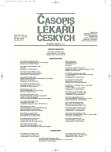Means of early diagnostics and subsequent care for critically ill patient
Authors:
Roman Mottl
Authors‘ workplace:
Fakultní nemocnice v Hradci Králové, Interní JIP, Klinika gerontologická a metabolická
Published in:
Čas. Lék. čes. 2010; 149: 221-224
Category:
Original Article
Overview
Background.
The delayed identification of an unstable patient may lead to the delayed management or the delayed transfer of the patient to the Intensive care unit and this can be related to the increase in the risk of death.
Methods.
Early warning score (EWS) respectively modified early warning score (MEWS) is the system that helps in the early identification of the patient’s deteriorating status and may decrease both mortality and morbidity.
Results and conclusions.
The introducing of the specialized teams as Medical emergency team or more complex Intensive care unit outreach service is related to the increased chance of unstable patient to meet earlier medical support specialized in intensive care. The above mentioned specialized teams may – according to some data – reduce the hospital mortality, incidence of cardiorespiratory arrest as well as the incidence of the unplanned Intensive care unit admissions.
Key words:
early waning score, modified early warning score, medical emergency team, Outreach service, acutely ill patient.
Sources
1. McQuillan P, Pilkington S, Allan A, et al. Confidential inquiry into quality of care before admission to intensive careBMJ 1998; 316 : 1853–1858.
2. Buist MD, et al. Recognising clinical instability in hospital patients before cardiac arrest or unplanned admission to intensive care. A pilot study in a tertiary-care hospital. Med J Aust 1999; 171 : 22–25.
3. Subbe CP, et al. Validation of a modified Early Warning Score in medical admissions. Quarterly Journal of Medicine 2001; 94 : 521–526.
4. Fieselmann J, et al. Respiratory rate predicts cardiopulmonary arrest for internal medicine patients. The Journal of General Internal Medicine 1993; 8 : 354–360.
5. Goldhill DR, et al. A physiologically-based early warning score for ward patients: the association between score and outcome. Anaesthesia 2005; 60(6): 547–553.
6. Cuthbertson BH, Smith GB. A warning on early-warning scores! British Journal of Anaesthesia 2007; 98(6): 704–706.
7. Stenhouse C, et al. Prospective evaluation of a modified Early Warning Score to aid earlier detection of patients developing critical illness on a general surgical ward. British Journal of Anaesthesia 2000; 84(5): 663.
8. Fairclough E, et al. Evaluation of a modified early warning system for acute medical admissions and comparison with C‑reactive protein/albumin ratio as a predictor of patient outcome. Clin Med 2009; 9(1): 30–33.
9. Cei M, Bartolomei C, Mumoli N. In-hospital mortality and morbidity of elderly medical patients can be predicted at admission by the Modified Early Warning Score: a prospective study. Int J Clin Pract 2009; 63(4): 591–595.
10. Groarke JD, et al. Use of an admission early warning score to predict patient morbidity and mortality and treatment success. Emerg Med J 2008; 25(12): 803–806.
11. Buist D, et al. Effects of a medical emergency team on the reduction of incidence of and mortality from unexpected cardiac arrests in hospital: preliminary review. British Medical Journal 2002; 324 : 387–390.
12. DeVita MA, et al. Use of medical emergency team responses to reduce hospital cardiopulmonary arrests. Qual Saf Health Care 2004; (4): 251–254.
13. MERIT study investigators: Introduction of the medical emergency team (MET) system: a cluster-randomised controlled trial. The Lancet 2005; 365 : 2091–2097.
14. Pavlík M, et al. Časné vyhledávání kriticky nemocných pomocí Medical Emergency System ve Fakultní nemocnici u svaté Anny v Brně. Anest intenziv Med 2009; 20(4): s. 185–191.
15. Pittard AJ. Out of our reach? Assessing the impact of introducing a critical care outreach service. Anaesthesia 2003; 58(9): 882–885.
16. Priestley et al. Introducing Critical Care Outreach: a ward-randomised trial of phased introduction in a general hospital. Intensive Care Med 2004; 30(7): 1261–1262.
17. McGaughey J, et al. Outreach and Early Warning Systems (EWS) for the prevention of intensive care admission and death of critically ill adult patients on general hospital wards. Cochrane Database Syst Rev 2007; (3): CD005529.
Labels
Addictology Allergology and clinical immunology Angiology Audiology Clinical biochemistry Dermatology & STDs Paediatric gastroenterology Paediatric surgery Paediatric cardiology Paediatric neurology Paediatric ENT Paediatric psychiatry Paediatric rheumatology Diabetology Pharmacy Vascular surgery Pain management Dental HygienistArticle was published in
Journal of Czech Physicians

Most read in this issue
- Shy-Drager syndrome
- Means of early diagnostics and subsequent care for critically ill patient
- Buchvald D. Contact dermatitis and atopic dermatitis – rare comorbidity?
- Growth hormone deficiency, its influence on bone mineral density and incidence of osteoporotic fractures
